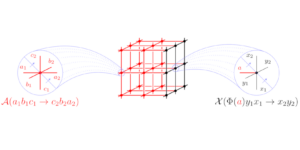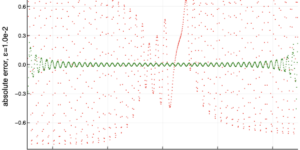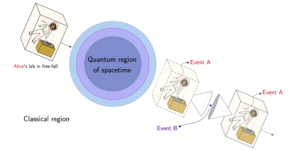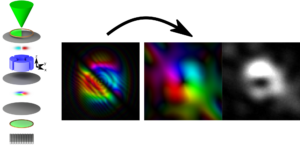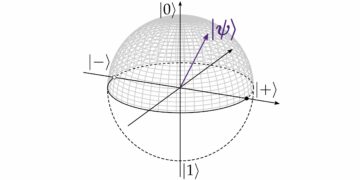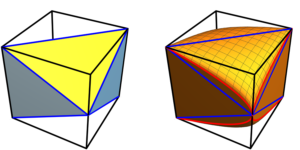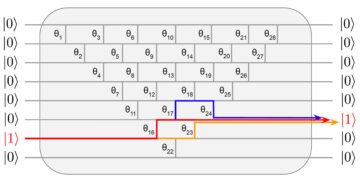1گروه شیمی فیزیک، دانشگاه کشور باسک UPV/EHU، آپارتادو 644، 48080 بیلبائو، اسپانیا
2EHU Quantum Center, University of the Basque Country UPV/EHU, Apartado 644, 48080 Bilbao, Spain
3School of Applied and Engineering Physics, Cornell University, Ithaca, NY 14853, USA
4TECNALIA, Basque Research and Technology Alliance (BRTA), 48160 Derio, Spain
5IKERBASQUE, Basque Foundation for Science, Plaza Euskadi 5, 48009, Bilbao, Spain
6Basque Center for Applied Mathematics (BCAM), Alameda de Mazarredo, 14, 48009 Bilbao, Spain
این مقاله را جالب می دانید یا می خواهید بحث کنید؟ SciRate را ذکر کنید یا در SciRate نظر بدهید.
چکیده
Loading functions into quantum computers represents an essential step in several quantum algorithms, such as quantum partial differential equation solvers. Therefore, the inefficiency of this process leads to a major bottleneck for the application of these algorithms. Here, we present and compare two efficient methods for the amplitude encoding of real polynomial functions on $n$ qubits. This case holds special relevance, as any continuous function on a closed interval can be uniformly approximated with arbitrary precision by a polynomial function. The first approach relies on the matrix product state representation (MPS). We study and benchmark the approximations of the target state when the bond dimension is assumed to be small. The second algorithm combines two subroutines. Initially we encode the linear function into the quantum registers either via its MPS or with a shallow sequence of multi-controlled gates that loads the linear function’s Hadamard-Walsh series, and we explore how truncating the Hadamard-Walsh series of the linear function affects the final fidelity. Applying the inverse discrete Hadamard-Walsh transform converts the state encoding the series coefficients into an amplitude encoding of the linear function. Thus, we use this construction as a building block to achieve an exact block encoding of the amplitudes corresponding to the linear function on $k_0$ qubits and apply the quantum singular value transformation that implements a polynomial transformation to the block encoding of the amplitudes. This unitary together with the Amplitude Amplification algorithm will enable us to prepare the quantum state that encodes the polynomial function on $k_0$ qubits. Finally we pad $n-k_0$ qubits to generate an approximated encoding of the polynomial on $n$ qubits, analyzing the error depending on $k_0$. In this regard, our methodology proposes a method to improve the state-of-the-art complexity by introducing controllable errors.
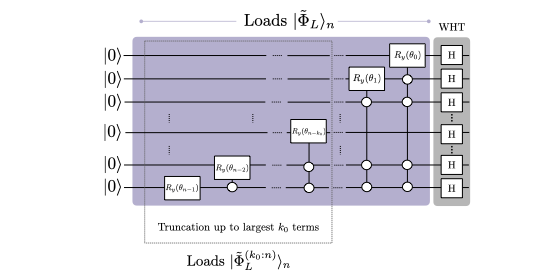
خلاصه محبوب
► داده های BibTeX
◄ مراجع
[1] فرانک آروت، کونال آریا، رایان بابوش، دیو بیکن، جوزف سی باردین، رامی بارندز، روپاک بیسواس، سرجیو بویکسو، فرناندو جی اس ال براندائو، دیوید آ. بوئل، برایان بورکت، یو چن، زیجون چن، بن کیارو، روبرتو کالینز، ویلیام کورتنی، اندرو دانسورث، ادوارد فرهی، بروکس فاکسن، آستین فاولر، کریگ گیدنی، ماریسا گیستینا، راب گراف، کیث گورین، استیو هابگر، متیو پی. هریگان، مایکل جی هارتمن، آلن هو، مارکوس هافمن، ترنت هوانگ، تراویس اس. فروتن، سرگئی وی. ایزاکوف، ایوان جفری، ژانگ جیانگ، دویر کافری، کوستیانتین کچجی، جولیان کلی، پل وی. کلیموف، سرگئی کنیش، الکساندر کوروتکوف، فدور کوستریتسا، دیوید لاندهویس، مایک لیندمارک، اریک لوسرو، دیمیتری لیاخ، سالواتوره ماندرا، جارود آر. مککلین، متیو مک ایون، آنتونی مگرنت، شیائو می، کریستل میشیلسن، مسعود محسنی، جاش موتوس، اوفر نعمان، متیو نیلی، چارلز نیل، مورفی یوئژن نیو، اریک اوستبی، آندره پتوخوف، جان سی. کریس کوینتانا، النور جی. ریفل، پدرام روشن، نیکلاس سی روبین، دانیل سانک، کوین جی ساتزینگر، وادیم اسملیانسکی، کوین جی سانگ، متیو دی. ترویتیک، آمیت واینسنچر، بنجامین ویلانگا، تئودور وایت، ز. جیمی یائو ، پینگ یه، آدام زالکمن، هارتموت نون و جان ام. مارتینیس. "برتری کوانتومی با استفاده از یک پردازنده ابررسانا قابل برنامه ریزی". Nature 574, 505–510 (2019).
https://doi.org/10.1038/s41586-019-1666-5
[2] Yulin Wu, Wan-Su Bao, Sirui Cao, Fusheng Chen, Ming-Cheng Chen, Xiawei Chen, Tung-Hsun Chung, Hui Deng, Yajie Du, Daojin Fan, Ming Gong, Cheng Guo, Chu Guo, Shaojun Guo, Lianchen Han, Linyin Hong, He-Liang Huang, Yong-Heng Huo, Liping Li, Na Li, Shaowei Li, Yuan Li, Futian Liang, Chun Lin, Jin Lin, Haoran Qian, Dan Qiao, Hao Rong, Hong Su, Lihua Sun, Liangyuan Wang, Shiyu Wang, Dachao Wu, Yu Xu, Kai Yan, Weifeng Yang, Yang Yang, Yangsen Ye, Jianghan Yin, Chong Ying, Jiale Yu, Chen Zha, Cha Zhang, Haibin Zhang, Kaili Zhang, Yiming Zhang, Han Zhao, Youwei Zhao, Liang Zhou, Qingling Zhu, Chao-Yang Lu, Cheng-Zhi Peng, Xiaobo Zhu, and Jian-Wei Pan. “Strong quantum computational advantage using a superconducting quantum processor”. Physical Review Letters 127 (2021).
https://doi.org/10.1103/PhysRevLett.127.180501
[3] هان سن ژونگ، هوی وانگ، یو هائو دنگ، مینگ چنگ چن، لی چائو پنگ، یی هان لو، جیان چین، دیان وو، زینگ دینگ، یی هو، پنگ هو، شیائو-یان یانگ، وی- جون ژانگ، هائو لی، یوشوان لی، شیائو جیانگ، لین گان، گوانگ ون یانگ، لیکسینگ یو، ژن وانگ، لی لی، نای-له لیو، چائو یانگ لو و جیان وی پان. "مزیت محاسباتی کوانتومی با استفاده از فوتون". Science 370, 1460-1463 (2020).
https://doi.org/10.1126/science.abe8770
[4] Dolev Bluvstein, Simon J. Evered, Alexandra A. Geim, Sophie H. Li, Hengyun Zhou, Tom Manovitz, Sepehr Ebadi, Madelyn Cain, Marcin Kalinowski, Dominik Hangleiter, J. Pablo Bonilla Ataides, Nishad Maskara, Iris Cong, Xun Gao, Pedro Sales Rodriguez, Thomas Karolyshyn, Giulia Semeghini, Michael J. Gullans, Markus Greiner, Vladan Vuletić, and Mikhail D. Lukin. “Logical quantum processor based on reconfigurable atom arrays”. Nature (2023).
https://doi.org/10.1038/s41586-023-06927-3
[5] آرام دبلیو هارو، آوینتان حسیدیم و ست لوید. "الگوریتم کوانتومی برای سیستم های معادلات خطی". فیزیک کشیش لِت 103, 150502 (2009).
https://doi.org/10.1103/PhysRevLett.103.150502
[6] اندرو ام. چایلدز، رابین کوتاری و رولاندو دی. ساما. "الگوریتم کوانتومی برای سیستم های معادلات خطی با وابستگی نمایی بهبود یافته به دقت". SIAM Journal on Computing 46، 1920-1950 (2017).
https://doi.org/10.1137/16M1087072
[7] Nathan Wiebe, Daniel Braun, and Seth Lloyd. “Quantum algorithm for data fitting”. Phys. Rev. Lett. 109, 050505 (2012).
https://doi.org/10.1103/PhysRevLett.109.050505
[8] B. D. Clader, B. C. Jacobs, and C. R. Sprouse. “Preconditioned quantum linear system algorithm”. Phys. Rev. Lett. 110, 250504 (2013).
https://doi.org/10.1103/PhysRevLett.110.250504
[9] Artur Scherer, Benoı̂t Valiron, Siun-Chuon Mau, Scott Alexander, Eric van den Berg, and Thomas E. Chapuran. “Concrete resource analysis of the quantum linear-system algorithm used to compute the electromagnetic scattering cross section of a 2d target”. Quantum Information Processing 16 (2017).
https://doi.org/10.1007/s11128-016-1495-5
[10] پاتریک ربنتروست، براجش گوپت و توماس آر. بروملی. "مالی محاسباتی کوانتومی: قیمت گذاری مونت کارلو مشتقات مالی". فیزیک Rev. A 98, 022321 (2018).
https://doi.org/10.1103/PhysRevA.98.022321
[11] Nikitas Stamatopoulos, Daniel J. Egger, Yue Sun, Christa Zoufal, Raban Iten, Ning Shen, and Stefan Woerner. “Option pricing using quantum computers”. Quantum 4, 291 (2020).
https://doi.org/10.22331/q-2020-07-06-291
[12] Ana Martin, Bruno Candelas, Á ngel Rodríguez-Rozas, José D. Martín-Guerrero, Xi Chen, Lucas Lamata, Román Orús, Enrique Solano, and Mikel Sanz. “Toward pricing financial derivatives with an IBM quantum computer”. Physical Review Research 3 (2021).
https://doi.org/10.1103/PhysRevResearch.3.013167
[13] Javier Gonzalez-Conde, Ángel Rodríguez-Rozas, Enrique Solano, and Mikel Sanz. “Efficient Hamiltonian simulation for solving option price dynamics”. Phys. Rev. Research 5, 043220 (2023).
https://doi.org/10.1103/PhysRevResearch.5.043220
[14] Dylan Herman, Cody Googin, Xiaoyuan Liu, Yue Sun, Alexey Galda, Ilya Safro, Marco Pistoia, and Yuri Alexeev. “Quantum computing for finance”. Nature Reviews Physics (2023).
https://doi.org/10.1038/s42254-023-00603-1
[15] رومان اروس، ساموئل موگل و انریکه لیزاسو. محاسبات کوانتومی برای امور مالی: بررسی اجمالی و چشم انداز بررسیها در فیزیک 4، 100028 (2019).
https://doi.org/10.1016/j.revip.2019.100028
[16] دانیل جی اگر، کلودیو گامبلا، یاکوب مارسک، اسکات مک فادین، مارتین میویسن، رودی ریموند، آندریا سیمونتو، استفان وورنر و النا یندوراین. محاسبات کوانتومی برای امور مالی: پیشرفته ترین و چشم اندازهای آینده معاملات IEEE در مهندسی کوانتومی 1، 1-24 (2020).
https://doi.org/10.1109/TQE.2020.3030314
[17] Gabriele Agliardi, Corey O’Meara, Kavitha Yogaraj, Kumar Ghosh, Piergiacomo Sabino, Marina Fernández-Campoamor, Giorgio Cortiana, Juan Bernabé-Moreno, Francesco Tacchino, Antonio Mezzacapo, and Omar Shehab. “Quadratic quantum speedup in evaluating bilinear risk functions” (2023). arXiv:2304.10385.
https://doi.org/10.48550/arXiv.2304.10385
arXiv: 2304.10385
[18] Sarah K. Leyton and Tobias J. Osborne. “A quantum algorithm to solve nonlinear differential equations” (2008). arXiv:0812.4423.
https://doi.org/10.48550/arXiv.0812.4423
arXiv: 0812.4423
[19] دومینیک دبلیو بری، اندرو ام. چایلدز، آرون اوستراندر و گومینگ وانگ. "الگوریتم کوانتومی برای معادلات دیفرانسیل خطی با وابستگی نمایی بهبود یافته به دقت". ارتباطات در فیزیک ریاضی 356، 1057-1081 (2017).
https://doi.org/10.1007/s00220-017-3002-y
[20] Jin-Peng Liu, Herman Øie Kolden, Hari K. Krovi, Nuno F. Loureiro, Konstantina Trivisa, and Andrew M. Childs. “Efficient quantum algorithm for dissipative nonlinear differential equations”. Proceedings of the National Academy of Sciences 118 (2021).
https://doi.org/10.1073/pnas.2026805118
[21] Benjamin Zanger, Christian B. Mendl, Martin Schulz, and Martin Schreiber. “Quantum algorithms for solving ordinary differential equations via classical integration methods”. Quantum 5, 502 (2021).
https://doi.org/10.22331/q-2021-07-13-502
[22] Juan José García-Ripoll. “Quantum-inspired algorithms for multivariate analysis: from interpolation to partial differential equations”. Quantum 5, 431 (2021).
https://doi.org/10.22331/q-2021-04-15-431
[23] Pablo Rodriguez-Grasa, Ruben Ibarrondo, Javier Gonzalez-Conde, Yue Ban, Patrick Rebentrost, Mikel Sanz. “Quantum approximated cloning-assisted density matrix exponentiation” (2023). arXiv:2311.11751.
https://doi.org/10.48550/arXiv.2311.11751
arXiv: 2311.11751
[24] Dong An, Di Fang, Stephen Jordan, Jin-Peng Liu, Guang Hao Low, and Jiasu Wang, “Efficient quantum algorithm for nonlinear reaction-diffusion equations and energy estimation,” (2022). arXiv:2305.11352.
https://doi.org/10.48550/arXiv.2205.01141
arXiv: 2305.11352
[25] Dylan Lewis, Stephan Eidenbenz, Balasubramanya Nadiga, and Yiğit Subaşı, “Limitations for quantum algorithms to solve turbulent and chaotic systems,” (2023) arXiv:2307.09593.
https://doi.org/10.48550/arXiv.2307.09593
arXiv: 2307.09593
[26] Yen Ting Lin, Robert B. Lowrie, Denis Aslangil, Yiğit Subaşı, and Andrew T. Sornborger , “Koopman-von Neumann mechanics and the Koopman representation: A perspective on solving nonlinear dynamical systems with quantum computers,” (2022) arXiv:2202.02188.
https://doi.org/10.48550/arXiv.2202.02188
arXiv: 2202.02188
[27] Shi Jin, Nana Liu, and Yue Yu, “Time complexity analysis of quantum algorithms via linear representations for nonlinear ordinary and partial differential equations,” Journal of Computational Physics, vol. 487, p. 112149, (2023).
https://doi.org/10.1016/j.jcp.2023.112149
[28] Ilon Joseph, “Koopman–von Neumann approach to quantum simulation of nonlinear classical dynamics,” Phys. Rev. Res., vol. 2, p. 043102, (2020).
https://doi.org/10.1103/PhysRevResearch.2.043102
[29] David Jennings, Matteo Lostaglio, Robert B. Lowrie, Sam Pallister, and Andrew T. Sornborger, “The cost of solving linear differential equations on a quantum computer: fast-forwarding to explicit resource counts,” (2023) arXiv:2309.07881.
https://doi.org/10.48550/arXiv.2309.07881
arXiv: 2309.07881
[30] David Jennings, Matteo Lostaglio, Sam Pallister, Andrew T Sornborger, and Yiğit Subaşı, “Efficient quantum linear solver algorithm with detailed running costs,” (2023) arXiv:2305.11352.
https://doi.org/10.48550/arXiv.2305.11352
arXiv: 2305.11352
[31] Javier Gonzalez-Conde and Andrew T. Sornborger “Mixed Quantum-Semiclassical Simulation,” (2023) arXiv:2308.16147.
https://doi.org/10.48550/arXiv.2308.16147
arXiv: 2308.16147
[32] Dimitrios Giannakis, Abbas Ourmazd, Philipp Pfeffer, Joerg Schumacher, and Joanna Slawinska, “Embedding classical dynamics in a quantum computer,” Phys. Rev. A, vol. 105, p. 052404, (2022).
https://doi.org/10.48550/arXiv.2012.06097
[33] François Gay-Balmaz and Cesare Tronci, “Evolution of hybrid quantum–classical wavefunctions,” Physica D: Nonlinear Phenomena, vol. 440, p. 133450, (2022).
https://doi.org/10.1016/j.physd.2022.133450
[34] Denys I. Bondar, François Gay-Balmaz and Cesare Tronci, “Koopman wavefunctions and classical–quantum correlation dynamics,” Proceedings of the Royal Society A, vol. 475, no. 2229, p. 20180879, (2019).
https://doi.org/10.1098/rspa.2018.0879
[35] جان پرسکیل. محاسبات کوانتومی در عصر NISQ و فراتر از آن Quantum 2, 79 (2018).
https://doi.org/10.22331/q-2018-08-06-79
[36] Vojtěch Havlíček، Antonio D. Córcoles، Kristan Temme، Aram W. Harrow، Abhinav Kandala، Jerry M. Chow و Jay M. Gambetta. "یادگیری تحت نظارت با فضاهای ویژگی های پیشرفته کوانتومی". Nature 567, 209–212 (2019).
https://doi.org/10.1038/s41586-019-0980-2
[37] یونچائو لیو، سرینیواسان آروناچلام، و کرستان تممه. "یک افزایش سرعت کوانتومی دقیق و قوی در یادگیری ماشینی نظارت شده". Nature Physics 17، 1013–1017 (2021).
https://doi.org/10.1038/s41567-021-01287-z
[38] ماریا شولد، رایان سوکه و یوهانس یاکوب مایر. "تأثیر رمزگذاری داده ها بر قدرت بیان مدل های کوانتومی-ماشین-یادگیری متغیر". فیزیک Rev. A 103, 032430 (2021).
https://doi.org/10.1103/PhysRevA.103.032430
[39] Maria Schuld and Francesco Petruccione. “Quantum models as kernel methods”. Pages 217–245. Springer International Publishing. Cham (2021).
https://doi.org/10.1007/978-3-030-83098-4_6
[40] Seth Lloyd, Maria Schuld, Aroosa Ijaz, Josh Izaac, and Nathan Killoran. “Quantum embeddings for machine learning” (2020). arXiv:2001.03622.
https://doi.org/10.48550/arXiv.2001.03622
arXiv: 2001.03622
[41] سام مک آردل، آندرس گیلین و ماریو برتا. "آماده سازی حالت کوانتومی بدون محاسبات منسجم" (2022). arXiv:2210.14892.
https://doi.org/10.48550/arXiv.2210.14892
arXiv: 2210.14892
[42] H. Li, H. Ni, L. Ying. “On efficient quantum block encoding of pseudo-differential operators”. Quantum 7, 1031 (2023).
https://doi.org/10.22331/q-2023-06-02-1031
[43] Mikko Mottonen, Juha J. Vartiainen, Ville Bergholm, and Martti M. Salomaa. “Transformation of quantum states using uniformly controlled rotations” (2004). arXiv:quant-ph/0407010.
https://doi.org/10.48550/arXiv.quant-ph/0407010
arXiv:quant-ph/0407010
[44] Xiaoming Sun, Guojing Tian, Shuai Yang, Pei Yuan, and Shengyu Zhang. “Asymptotically optimal circuit depth for quantum state preparation and general unitary synthesis” (2023). arXiv:2108.06150.
https://doi.org/10.48550/arXiv.2108.06150
arXiv: 2108.06150
[45] شیائو مینگ ژانگ، من هونگ یونگ و شیائو یوان. "آماده سازی حالت کوانتومی با عمق کم". فیزیک Rev. Res. 3, 043200 (2021).
https://doi.org/10.1103/PhysRevResearch.3.043200
[46] Israel F. Araujo, Daniel K. Park, Francesco Petruccione, and Adenilton J. da Silva. “A divide-and-conquer algorithm for quantum state preparation”. Scientific Reports 11 (2021).
https://doi.org/10.1038/s41598-021-85474-1
[47] Jian Zhao, Yu-Chun Wu, Guang-Can Guo, and Guo-Ping Guo. “State preparation based on quantum phase estimation” (2019). arXiv:1912.05335.
https://doi.org/10.48550/arXiv.1912.05335
arXiv: 1912.05335
[48] Lov K. Grover. “Synthesis of quantum superpositions by quantum computation”. Phys. Rev. Lett. 85, 1334–1337 (2000).
https://doi.org/10.1103/PhysRevLett.85.1334
[49] Yuval R. Sanders, Guang Hao Low, Artur Scherer, and Dominic W. Berry. “Black-box quantum state preparation without arithmetic”. Phys. Rev. Lett. 122, 020502 (2019).
https://doi.org/10.1103/PhysRevLett.122.020502
[50] Johannes Bausch. “Fast Black-Box Quantum State Preparation”. Quantum 6, 773 (2022).
https://doi.org/10.22331/q-2022-08-04-773
[51] لاو گروور و تری رودولف. "ایجاد برهمنهیهایی که با توزیعهای احتمال ادغامپذیر کارآمد مطابقت دارند" (2002). arXiv:quant-ph/0208112.
https://doi.org/10.48550/arXiv.quant-ph/0208112
arXiv:quant-ph/0208112
[52] Arthur G. Rattew and Bálint Koczor. “Preparing arbitrary continuous functions in quantum registers with logarithmic complexity” (2022). arXiv:2205.00519.
https://doi.org/10.48550/arXiv.2205.00519
arXiv: 2205.00519
[53] Shengbin Wang, Zhimin Wang, Runhong He, Shangshang Shi, Guolong Cui, Ruimin Shang, Jiayun Li, Yanan Li, Wendong Li, Zhiqiang Wei, and Yongjian Gu. “Inverse-coefficient black-box quantum state preparation”. New Journal of Physics 24, 103004 (2022).
https://doi.org/10.1088/1367-2630/ac93a8
[54] شیائو مینگ ژانگ، تونگ یانگ لی و شیائو یوان. "آماده سازی حالت کوانتومی با عمق مدار بهینه: پیاده سازی ها و کاربردها". فیزیک کشیش لِت 129, 230504 (2022).
https://doi.org/10.1103/PhysRevLett.129.230504
[55] Gabriel Marin-Sanchez, Javier Gonzalez-Conde, and Mikel Sanz. “Quantum algorithms for approximate function loading”. Phys. Rev. Research. 5, 033114 (2023).
https://doi.org/10.1103/PhysRevResearch.5.033114
[56] Kouhei Nakaji, Shumpei Uno, Yohichi Suzuki, Rudy Raymond, Tamiya Onodera, Tomoki Tanaka, Hiroyuki Tezuka, Naoki Mitsuda, and Naoki Yamamoto. “Approximate amplitude encoding in shallow parameterized quantum circuits and its application to financial market indicators”. Phys. Rev. Res. 4, 023136 (2022).
https://doi.org/10.1103/PhysRevResearch.4.023136
[57] کریستا زوفال، اورلین لوچی و استفان وورنر. "شبکه های متخاصم مولد کوانتومی برای یادگیری و بارگذاری توزیع های تصادفی". npj Quantum Information 5, 103 (2019).
https://doi.org/10.1038/s41534-019-0223-2
[58] Julien Zylberman and Fabrice Debbasch. “Efficient quantum state preparation with walsh series” (2023). arXiv:2307.08384.
https://doi.org/10.48550/arXiv.2307.08384
arXiv: 2307.08384
[59] Mudassir Moosa, Thomas W. Watts, Yiyou Chen, Abhijat Sarma, and Peter L. McMahon. “Linear-depth quantum circuits for loading fourier approximations of arbitrary functions” . In Quantum Science and Technology (Vol. 9, Issue 1, p. 015002) (2023).
https://doi.org/10.1088/2058-9565/acfc62
[60] Lars Grasedyck. “Polynomial approximation in hierarchical tucker format by vector – tensorization” (2010). Mathematics, Computer Science.
https://api.semanticscholar.org/CorpusID:15557599
[61] Adam Holmes and A. Y. Matsuura. “Efficient quantum circuits for accurate state preparation of smooth, differentiable functions” (2020). arXiv:2005.04351.
https://doi.org/10.48550/arXiv.2005.04351
arXiv: 2005.04351
[62] Adam Holmes and A. Y. Matsuura. “Entanglement properties of quantum superpositions of smooth, differentiable functions” (2020). arXiv:2009.09096.
https://doi.org/10.48550/arXiv.2009.09096
arXiv: 2009.09096
[63] Ar A Melnikov، AA Termanova، SV Dolgov، F Neukart و MR Perelshtein. "آماده سازی حالت کوانتومی با استفاده از شبکه های تانسور". علوم و فناوری کوانتومی 8, 035027 (2023).
https://doi.org/10.1088/2058-9565/acd9e7
[64] Rohit Dilip, Yu-Jie Liu, Adam Smith, and Frank Pollmann. “Data compression for quantum machine learning”. Phys. Rev. Res. 4, 043007 (2022).
https://doi.org/10.1103/PhysRevResearch.4.043007
[65] Sheng-Hsuan Lin, Rohit Dilip, Andrew G. Green, Adam Smith, and Frank Pollmann. “Real- and imaginary-time evolution with compressed quantum circuits”. PRX Quantum 2 (2021).
https://doi.org/10.1103/prxquantum.2.010342
[66] Michael Lubasch, Pierre Moinier, and Dieter Jaksch. “Multigrid renormalization”. Journal of Computational Physics 372, 587–602 (2018).
https://doi.org/10.1016/j.jcp.2018.06.065
[67] مایکل لوباش، جائو جو، پیر موینیر، مارتین کیفنر و دیتر جاکس. الگوریتم های کوانتومی متغیر برای مسائل غیرخطی فیزیک Rev. A 101, 010301 (2020).
https://doi.org/10.1103/PhysRevA.101.010301
[68] Nikita Gourianov, Michael Lubasch, Sergey Dolgov, Quincy Y. van den Berg, Hessam Babaee, Peyman Givi, Martin Kiffner, and Dieter Jaksch. “A quantum-inspired approach to exploit turbulence structures”. Nature Computational Science 2, 30–37 (2022).
https://doi.org/10.1038/s43588-021-00181-1
[69] Jason Iaconis, Sonika Johri, and Elton Yechao Zhu. “Quantum state preparation of normal distributions using matrix product states” (2023). arXiv:2303.01562.
https://doi.org/10.1038/s41534-024-00805-0
arXiv: 2303.01562
[70] Vanio Markov, Charlee Stefanski, Abhijit Rao, and Constantin Gonciulea. “A generalized quantum inner product and applications to financial engineering” (2022). arXiv:2201.09845.
https://doi.org/10.48550/arXiv.2201.09845
arXiv: 2201.09845
[71] Nikitas Stamatopoulos, Daniel J. Egger, Yue Sun, Christa Zoufal, Raban Iten, Ning Shen, and Stefan Woerner. “Option pricing using quantum computers”. Quantum 4, 291 (2020).
https://doi.org/10.22331/q-2020-07-06-291
[72] Guang Hao Low, Theodore J. Yoder, and Isaac L. Chuang. “Methodology of resonant equiangular composite quantum gates”. Phys. Rev. X 6, 041067 (2016).
https://doi.org/10.1103/PhysRevX.6.041067
[73] گوانگ هائو لو و آیزاک ال. چوانگ. "شبیه سازی هامیلتونی بهینه با پردازش سیگنال کوانتومی". فیزیک کشیش لِت 118, 010501 (2017).
https://doi.org/10.1103/PhysRevLett.118.010501
[74] گوانگ هائو لو و آیزاک ال. چوانگ. "شبیه سازی همیلتونی با کیوبیت سازی". Quantum 3, 163 (2019).
https://doi.org/10.22331/q-2019-07-12-163
[75] András Gilyén, Yuan Su, Guang Hao Low, and Nathan Wiebe. “Quantum singular value transformation and beyond: exponential improvements for quantum matrix arithmetics”. In Proceedings of the 51st Annual ACM SIGACT Symposium on Theoryof Computing ACM (2019).
https://doi.org/10.1145/3313276.3316366
[76] Ewin Tang and Kevin Tian. “A cs guide to the quantum singular value transformation” (2023). arXiv:2302.14324.
https://doi.org/10.48550/arXiv.2302.14324
arXiv: 2302.14324
[77] Yulong Dong, Xiang Meng, K. Birgitta Whaley, and Lin Lin. “Efficient phase-factor evaluation in quantum signal processing”. Phys. Rev. A 103, 042419 (2021).
https://doi.org/10.1103/PhysRevA.103.042419
[78] Naixu Guo, Kosuke Mitarai, and Keisuke Fujii. “Nonlinear transformation of complex amplitudes via quantum singular value transformation” (2021) arXiv:2107.10764.
https://doi.org/10.48550/arXiv.2107.10764
arXiv: 2107.10764
[79] Arthur G. Rattew and Patrick Rebentrost “Non-Linear Transformations of Quantum Amplitudes: Exponential Improvement, Generalization, and Applications” (2023) arXiv:2309.09839.
https://doi.org/10.48550/arXiv.2309.09839
arXiv: 2309.09839
[80] W. Fraser. “A Survey of Methods of Computing Minimax and Near-Minimax Polynomial Approximations for Functions of a Single Independent Variable”, Journal of the ACM 12, 295 (1965).
https://doi.org/10.1145/321281.321282
[81] E. Y. Remez, “General computational methods of Chebyshev approximation: The problems with linear real parameters”, (1963).
[82] Román Orús. “A practical introduction to tensor networks: Matrix product states and projected entangled pair states”. Annals of Physics (New York) (2014).
https://doi.org/10.1016/J.AOP.2014.06.013
[83] Guifré Vidal. “Efficient classical simulation of slightly entangled quantum computations”. Physical Review Letters 91 (2003).
https://doi.org/10.1103/physrevlett.91.147902
[84] F. Verstraete, V. Murg, and J.I. Cirac. “Matrix product states, projected entangled pair states, and variational renormalization group methods for quantum spin systems”. Advances in Physics 57, 143–224 (2008).
https://doi.org/10.1080/14789940801912366
[85] D. Perez-Garcia, F. Verstraete, M. M. Wolf, and J. I. Cirac. “Matrix product state representations”. Quantum Info. Comput. 7, 5, 401–430. (2007).
https://doi.org/10.26421/QIC7.5-6-1
[86] Shi-Ju Ran. “Encoding of matrix product states into quantum circuits of one- and two-qubit gates”. Physical Review A 101 (2020).
https://doi.org/10.1103/physreva.101.032310
[87] Daniel Malz, Georgios Styliaris, Zhi-Yuan Wei, and J. Ignacio Cirac. “Preparation of matrix product states with log-depth quantum circuits”. Phys. Rev. Lett. 132, 040404 (2024).
https://doi.org/10.1103/PhysRevLett.132.040404
[88] J. L. Walsh. “A closed set of normal orthogonal functions”. American Journal of Mathematics 45, 5–24 (1923).
https://doi.org/10.2307/2387224
[89] Michael E. Wall, Andreas Rechtsteiner, and Luis M. Rocha. “Singular value decomposition and principal component analysis”. Pages 91–109. Springer US. Boston, MA (2003).
https://doi.org/10.1007/0-306-47815-3_5
[90] Ivan Oseledets. “Constructive representation of functions in low-rank tensor formats”. Constructive Approximation 37 (2010).
https://doi.org/10.1007/s00365-012-9175-x
[91] Norbert Schuch, Michael M. Wolf, Frank Verstraete, and J. Ignacio Cirac. “Entropy scaling and simulability by matrix product states”. Physical Review Letters 100 (2008).
https://doi.org/10.1103/physrevlett.100.030504
[92] اولریش شولووک "گروه تراکم-ماتریس عادی سازی مجدد در عصر محصولات ماتریس". Annals of Physics 326، 96-192 (2011).
https://doi.org/10.1016/j.aop.2010.09.012
[93] Carl Eckart and G. Marion Young. “The approximation of one matrix by another of lower rank”. Psychometrika 1, 211–218 (1936).
https://doi.org/10.1007/BF02288367
[94] Manuel S. Rudolph, Jing Chen, Jacob Miller, Atithi Acharya, and Alejandro Perdomo-Ortiz. “Decomposition of matrix product states into shallow quantum circuits” (2022). arXiv:2209.00595.
https://doi.org/10.48550/arXiv.2209.00595
arXiv: 2209.00595
[95] C. Schön، E. Solano، F. Verstraete، JI Cirac، و MM Wolf. "تولید متوالی حالات چند کیوبیتی درهم". فیزیک کشیش لِت 95, 110503 (2005).
https://doi.org/10.1103/PhysRevLett.95.110503
[96] Vivek V. Shende, Igor L. Markov, and Stephen S. Bullock. “Minimal universal two-qubit controlled-NOT-based circuits”. Physical Review A 69 (2004).
https://doi.org/10.1103/physreva.69.062321
[97] آدریانو بارنکو، چارلز اچ. بنت، ریچارد کلیو، دیوید پی دی وینچنزو، نورمن مارگولوس، پیتر شور، تیکو اسلیتور، جان اسمولین، و هارالد واینفورتر. "دروازه های ابتدایی برای محاسبات کوانتومی". Physical Review A 52, 3457–3467 (1995).
https://doi.org/10.1103/physreva.52.3457
[98] اولریش شولووک "گروه تراکم-ماتریس عادی سازی مجدد در عصر محصولات ماتریس". Annals of Physics 326، 96-192 (2011).
https://doi.org/10.1016/j.aop.2010.09.012
[99] Jonathan Welch, Daniel Greenbaum, Sarah Mostame, and Alan Aspuru-Guzik. “Efficient quantum circuits for diagonal unitaries without ancillas”. New Journal of Physics 16, 033040 (2014).
https://doi.org/10.1088/1367-2630/16/3/033040
[100] شانتاناو چاکرابورتی، آندراس گیلین و استیسی جفری. «قدرت قدرتهای ماتریس کدگذاری شده با بلوک: تکنیکهای رگرسیون بهبودیافته از طریق شبیهسازی سریعتر همیلتونی». در کریستل بایر، یوآنیس شاتزیگیاناکیس، پائولا فلوکینی، و استفانو لئوناردی، ویراستاران، چهل و ششمین کنفرانس بینالمللی اتومات، زبانها و برنامهنویسی (ICALP 46). جلد 2019 مجموعه مقالات بین المللی لایبنیتس در انفورماتیک (LIPIcs)، صفحات 132:33-1:33. داگستول، آلمان (14). Schloss Dagstuhl–Leibniz-Zentrum fuer Informatik.
https://doi.org/10.4230/LIPIcs.ICALP.2019.33
[101] T. Constantinescu. “Schur parameters, factorization, and dilation problems”. Operator Theory: Advances and Applications. Birkhäuser Verlag. (1996).
https://doi.org/10.1007/978-3-0348-9108-0
[102] Shengbin Wang, Zhimin Wang, Wendong Li, Lixin Fan, Guolong Cui, Zhiqiang Wei, and Yongjian Gu. “Quantum circuits design for evaluating transcendental functions based on a function-value binary expansion method”. Quantum Information Processing 19 (2020).
https://doi.org/10.1007/s11128-020-02855-7
[103] Chung-Kwong Yuen. “Function approximation by walsh series”. IEEE Transactions on Computers C-24, 590–598 (1975).
https://doi.org/10.1109/T-C.1975.224271
[104] Rui Chao، Dawei Ding، Andras Gilyen، Cupjin Huang و Mario Szegedy. "یافتن زوایای پردازش سیگنال کوانتومی با دقت ماشین" (2020). arXiv:2003.02831.
https://doi.org/10.48550/arXiv.2003.02831
arXiv: 2003.02831
[105] جونگوان هاه. "تجزیه محصول توابع دوره ای در پردازش سیگنال کوانتومی". Quantum 3, 190 (2019).
https://doi.org/10.22331/q-2019-10-07-190
ذکر شده توسط
[1] Arthur G. Rattew and Patrick Rebentrost, “Non-Linear Transformations of Quantum Amplitudes: Exponential Improvement, Generalization, and Applications”, arXiv: 2309.09839, (2023).
[2] خاویر گونزالس-کونده، آنخل رودریگز-رزاس، انریکه سولانو و میکل سانز، "شبیه سازی کارآمد همیلتونی برای حل پویایی قیمت گزینه"، تحقیقات مروری فیزیکی 5 4، 043220 (2023).
[3] Paul Over, Sergio Bengoechea, Thomas Rung, Francesco Clerici, Leonardo Scandurra, Eugene de Villiers, and Dieter Jaksch, “Boundary Treatment for Variational Quantum Simulations of Partial Differential Equations on Quantum Computers”, arXiv: 2402.18619, (2024).
[4] پابلو رودریگز-گراسا، روبن ایباروندو، خاویر گونزالس-کوند، یو بان، پاتریک ربنتروست، و میکل سانز، "قدرت ماتریس چگالی به کمک شبیه سازی کوانتومی تقریبی"، arXiv: 2311.11751, (2023).
نقل قول های بالا از SAO/NASA Ads (آخرین به روز رسانی با موفقیت 2024-03-22 05:17:12). فهرست ممکن است ناقص باشد زیرا همه ناشران داده های استنادی مناسب و کاملی را ارائه نمی دهند.
On سرویس استناد شده توسط Crossref هیچ داده ای در مورد استناد به آثار یافت نشد (آخرین تلاش 2024-03-22 05:17:10).
این مقاله در Quantum تحت عنوان منتشر شده است Creative Commons Attribution 4.0 International (CC BY 4.0) مجوز. حق چاپ نزد دارندگان حق چاپ اصلی مانند نویسندگان یا مؤسسات آنها باقی می ماند.
- محتوای مبتنی بر SEO و توزیع روابط عمومی. امروز تقویت شوید.
- PlatoData.Network Vertical Generative Ai. به خودت قدرت بده دسترسی به اینجا.
- PlatoAiStream. هوش وب 3 دانش تقویت شده دسترسی به اینجا.
- PlatoESG. کربن ، CleanTech، انرژی، محیط، خورشیدی، مدیریت پسماند دسترسی به اینجا.
- PlatoHealth. هوش بیوتکنولوژی و آزمایشات بالینی. دسترسی به اینجا.
- منبع: https://quantum-journal.org/papers/q-2024-03-21-1297/
- :است
- :نه
- ][پ
- 001
- 06
- 09
- 1
- 10
- 100
- 11
- 118
- 12
- 13
- 14
- ٪۱۰۰
- 16
- 17
- 19
- 1995
- 1996
- 20
- 2000
- 2001
- 2005
- 2008
- 2009
- 2011
- 2012
- 2013
- 2014
- 2016
- 2017
- 2018
- 2019
- 2020
- 2021
- 2022
- 2023
- 2024
- 22
- 23
- 24
- 25
- ٪۱۰۰
- 27
- 28
- 29
- 2D
- 30
- 31
- 32
- 33
- ٪۱۰۰
- 36
- 39
- 40
- 41
- 43
- 475
- 49
- 50
- 51
- 54
- 58
- 60
- 65
- 66
- 67
- 7
- 70
- 72
- 75
- 77
- 8
- 80
- 84
- 87
- 89
- 9
- 91
- 97
- 98
- a
- آرون
- عباس
- بالاتر
- چکیده
- دانشگاه
- دسترسی
- دقیق
- رسیدن
- ACM
- آدم
- پیشرفت
- پیشرفت
- مزیت - فایده - سود - منفعت
- دشمن
- وابستگی ها
- سن
- گردشگاه عمومی
- آلن
- الکساندر
- الگوریتم
- الگوریتم
- معرفی
- اتحاد
- امریکایی
- تقویت
- an
- آنا
- تحلیل
- تجزیه و تحلیل
- و
- آندره
- اندرو
- سالیانه
- دیگر
- آنتونی
- هر
- کاربرد
- برنامه های کاربردی
- اعمال می شود
- درخواست
- با استفاده از
- روش
- تقریبی
- AR
- دلخواه
- هستند
- هنر
- آرتور
- اواز یکنفره
- AS
- فرض
- اتم
- کوشش
- آستین
- نویسنده
- نویسندگان
- بان کی مون
- مستقر
- BE
- در توی
- محک
- بنیامین
- خارج از
- مسدود کردن
- اوراق قرضه
- بوستون
- تنگنا
- مرز
- شکستن
- برایان
- برونو
- بنا
- by
- CAN
- کائو
- دهاتی
- مورد
- مرکز
- چا
- به چالش
- چائو یانگ لو
- چارلز
- شیمی
- چن
- چنگ
- چونگ
- چو
- کریس
- مسیحی
- بسته
- منسجم
- ترکیب
- توضیح
- مردم عادی
- ارتباطات
- مقايسه كردن
- کامل
- پیچیده
- پیچیدگی
- جزء
- محاسبه
- محاسباتی
- محاسبات
- محاسبه
- کامپیوتر
- علم کامپیوتر
- کامپیوتر
- محاسبه
- ساخت و ساز
- ساختمانی
- مداوم
- کنترل
- حق چاپ
- کرنل
- ارتباط
- متناظر
- هزینه
- هزینه
- کشور
- کریگ
- بحرانی
- صلیب
- جاری
- وضعیت فعلی
- da
- دانیل
- داده ها
- دیو
- داود
- de
- وابستگی
- بستگی دارد
- عمق
- مشتقات
- طرح
- دقیق
- بعد
- بحث و تبادل نظر
- توزیع
- دونگ
- دینامیک
- e
- سردبیران
- ادوارد
- موثر
- موثر
- هر دو
- قادر ساختن
- پشتیبانی می کند
- انرژی
- مهندسی
- افزایش
- معادلات
- عصر
- اریک
- اریک
- خطا
- خطاهای
- ضروری است
- یوجین
- ارزیابی
- ارزیابی
- اوان
- تکامل
- دقیق
- توسعه
- بهره برداری
- اکتشاف
- نمایی
- نمایی
- رسا
- پنکه
- سریعتر
- ویژگی
- وفاداری
- زمینه
- نهایی
- سرانجام
- سرمایه گذاری
- مالی
- مشتقات مالی
- بازار مالی
- نام خانوادگی
- مناسب
- برای
- قالب
- یافت
- پایه
- رک
- از جانب
- تابع
- توابع
- آینده
- GAO
- گیتس
- سوالات عمومی
- تعمیم یافته
- تولید می کنند
- نسل
- مولد
- آلمان
- گوگل
- سبز
- گروه
- استیفن گراور
- راهنمایی
- دانشگاه هاروارد
- he
- اینجا کلیک نمایید
- سلسله مراتبی
- دارندگان
- دارای
- هنگ
- چگونه
- HTTPS
- huang
- فروتن
- ترکیبی
- i
- آی بی ام
- کوانتومی آی بی ام
- IEEE
- عظیم
- پیاده سازی ها
- پیاده سازی می کند
- بهبود
- بهبود یافته
- بهبود
- ارتقاء
- in
- مستقل
- شاخص ها
- بی کفایتی
- اطلاعات
- اطلاعات
- در ابتدا
- داخلی
- موسسات
- ادغام
- جالب
- بین المللی
- به
- معرفی
- معرفی می کند
- معرفی
- معرفی
- معکوس
- اسرائيل
- موضوع
- ithaca
- ITS
- ایوان
- یعقوب
- جیمی
- جاوا اسکریپت
- جفری
- جنینگز
- جیان وی پان
- جان
- جاناتان
- اردن
- روزنامه
- یوحنا
- کیت
- کومار
- زبان ها
- نام
- منجر می شود
- یادگیری
- ترک کردن
- لوئیس
- Li
- مجوز
- ابشار
- خطی
- فهرست
- بارگیری
- بارهای
- کم
- کاهش
- دستگاه
- فراگیری ماشین
- عمده
- بسیاری
- اسیب
- مارکو
- مریم
- تفرجگاه ساحلی
- ماریو
- بازار
- مارتین
- ریاضی
- ریاضیات
- ماتریس
- متی
- حداکثر عرض
- ممکن است..
- مک کلین
- مکانیک
- روش
- روش شناسی
- روش
- مایر
- مایکل
- مخفف کلمه میکروفون
- میخائیل
- اسیابان
- مدل
- ماه
- ناتان
- ملی
- طبیعت
- شبکه
- جدید
- نیویورک
- نیکلاس
- نه
- غیر خطی
- طبیعی
- NY
- of
- ارائه
- عمر
- on
- ONE
- به سوی
- باز کن
- اپراتور
- اپراتور
- بهینه
- گزینه
- or
- عادی
- اصلی
- ما
- روی
- مروری
- پابلو
- لایی
- صفحات
- جفت
- مقاله
- پارامترهای
- پارک
- ویژه
- پاتریک
- پل
- متناوب
- چشم انداز
- از پا افتادن
- پیتر شور
- فاز
- فوتون ها
- فیزیکی
- فیزیک
- پیر
- پینگ
- افلاطون
- هوش داده افلاطون
- PlatoData
- پتانسیل
- قدرت
- قدرت
- عملی
- دقت
- تهیه
- آماده
- در حال حاضر
- ارائه
- قیمت
- قیمت گذاری
- اصلی
- مشکلات
- اقدامات
- روند
- در حال پردازش
- پردازنده
- محصول
- قابل برنامه ریزی
- برنامه نويسي
- پیش بینی
- امید بخش
- املاک
- پیشنهاد می کند
- چشم انداز
- ارائه
- منتشر شده
- ناشر
- ناشران
- انتشار
- کوانتومی
- الگوریتم های کوانتومی
- مزیت محاسباتی کوانتومی
- کامپیوتر کوانتومی
- کامپیوترهای کوانتومی
- اطلاعات کوانتومی
- یادگیری ماشین کوانتومی
- کیوبیت
- R
- رامی
- تصادفی
- رتبه بندی
- واقعی
- منابع
- نظر
- ثبت
- ربط
- تکیه می کند
- بقایای
- گزارش ها
- نمایندگی
- نشان دهنده
- تحقیق
- منابع
- احترام
- این فایل نقد می نویسید:
- بررسی
- ریچارد
- دقیق
- خطر
- دستبرد زدن
- رابرت
- سینه سرخ
- تنومند
- سلطنتی
- در حال اجرا
- رایان
- s
- حراجی
- سام
- سندرز
- مقیاس گذاری
- شون
- علم
- علم و تکنولوژی
- علوم
- علمی
- اسکات
- دوم
- بخش
- دنباله
- سلسله
- تنظیم
- چند
- کم عمق
- شور
- سیام
- سیگنال
- سیلوا
- شمعون
- شبیه سازی
- شبیه سازی
- تنها
- مفرد
- کوچک
- زرگر
- هموار کردن
- جامعه
- حل
- حل کردن
- فضاها
- ویژه
- چرخش
- سرینیواسان
- دولت
- وضعیت هنر
- ایالات
- استفان
- گام
- استفان
- استیو
- ساختار
- مهاجرت تحصیلی
- موفقیت
- چنین
- مناسب
- خورشید
- ابررسانا
- بررسی
- بزم پس از شام
- سنتز
- سیستم
- سیستم های
- برخورد با
- مقابله با
- زبانه
- هدف
- تکنیک
- پیشرفته
- تسکوکا
- که
- La
- بلوک
- ماتریکس
- دولت
- شان
- آنها
- نظریه
- از این رو
- اینها
- این
- توماس
- بدین ترتیب
- عنوان
- به
- با هم
- تام
- معاملات
- دگرگون کردن
- دگرگونی
- تحولات
- رفتار
- تلاطم
- سرکش
- دو
- زیر
- جهانی
- دانشگاه
- UNO
- به روز شده
- URL
- us
- استفاده کنید
- استفاده
- با استفاده از
- ارزش
- ون
- متغیر
- از طريق
- حجم
- W
- دیوار
- وانگ
- می خواهم
- بود
- وات
- we
- چه زمانی
- در حین
- سفید
- اراده
- ویلیام
- با
- در داخل
- بدون
- گرگ
- با این نسخهها کار
- wu
- X
- xi
- شیائو
- Ye
- سال
- ین
- هنوز
- YING
- نیویورک
- شما
- جوان
- یوان
- زفیرنت
- ژائو
- زونگ



